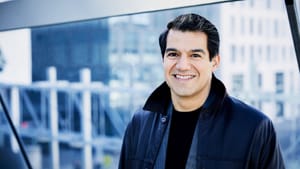Stay in the Loop
BSR publishes on a weekly schedule, with an email newsletter every Wednesday and Thursday morning. There’s no paywall, and subscribing is always free.
Border crossings
Philadelphia Orchestra presents 'South American Sounds'

Anyone operating under the assumption that classical music is dull should have stopped by the Kimmel Center last weekend. By any measure of taste or inclination, the Philadelphia Orchestra’s South American Sounds dished up a program of sizzlers.
Guest conductor Miguel Harth-Bedoya, the Fort Worth Symphony’s music director, led the Philadelphia Orchestra in four rousing compositions with syncopated rhythms, Latin flair, and memorable melodies. The works ranged from the 1930s to the past decade, appealing to an audience that is keenly appreciative of modern works with an edge.
Rare harp concerto
The program opened with a George Gershwin favorite, “Cuban Overture.” Composed in 1932 and originally called “Rumba,” the overture never let up on enticing tunes, searing brass, and a hot rhythm section with maracas, tom-tom, bongo, bells, and snares. If you’re used to hearing Cuban bands in classic films, just wait until you’ve heard what a major orchestra can do with a contemporary Latin beat.
The orchestra’s brilliant principal harpist, Elizabeth Hainen, dazzled with the second work on the program, Alberto Ginastera’s Harp Concerto. We don’t hear harp concertos very often today. Those by Glière, Mozart (harp, flute, and orchestra), Handel, and Boieldieu (you’d recognize it if you heard it) are among the most popular.
Problems with orchestral “balance” are cited as reasons the Ginastera has not been performed as frequently as it deserves, but those issues didn’t show in this performance, in part because of an electronically enhanced harp used onstage for the thunderous final movement.
The work develops purposefully, if unexpectedly across three movements. It travels from the strings’ first staccato syncopated phrases to the final driving rhythm, landing on a startling discord. After a briskly evocative allegro giusto in movement one, the second movement mournfully speaks to us from the basses and cellos.

Hainen’s touch is bold yet subtle. Always in total control of her instrument, she is ever listening: to the orchestra, to the conductor, to the spirit of music. The first two movements end in a whisper; the final movement begins with a motif based on the open strings of the guitar, then quakes with a timbre that is frenetic but wise. In a word, the concerto is a masterpiece worth a permanent place in the repertoire.
Peppy percussion
The third work on the program was “Tangazo,” by the ever-popular Astor Piazzolla. Like the second movement of the Ginastera, “Tangazo” opens with basses and cellos, this time in unison, its melody weaving through the orchestral instruments. The work contains some delicious fragments in the French horn and oboe, at times reaching a thundering crescendo.
As with other works on the program, the piece included some exciting percussive effects. These went as far as having concertmaster David Kim tapping on his violin, soon imitated by other string players.
While I was not enamored of the Piazzolla, which I found at times monotonous, the final work was riveting. Harth-Bedoya commissioned Jimmy López’s “Perú Negro” in 2013 to celebrate the Fort Worth Symphony’s centennial.
Though only 17 minutes long, the work is huge in vision and scope. It’s filled with a multitude of musical ideas, tremendous momentum, sense of proportion, and adventurous scoring with piercing brass and heart-stopping drums.
The work is inspired by Afro-Peruvian music but also pays tribute to the conductor by including several of his initials as notes in the musical score. Adding to the wonderful array of percussion are the cabasa, cowbells, jawbone, Mark tree, thunder sheet, and many other unique instruments, all given a master touch.
What, When, Where
South American Sounds. Miguel Harth-Bedoya, conductor; Elizabeth Hainen, harp. "Cuban Overture," by George Gershwin; Harp Concerto, Op. 25, by Alberto Ginastera; "Tangazo," by Astor Piazzolla; "Perú Negro," by Jimmy López. October 4-6, 2018, at the Kimmel Center's Verizon Hall, 300 S. Broad Street, Philadelphia. (215) 893-1999 or philorch.org.
Sign up for our newsletter
All of the week's new articles, all in one place. Sign up for the free weekly BSR newsletters, and don't miss a conversation.

 Linda Holt
Linda Holt